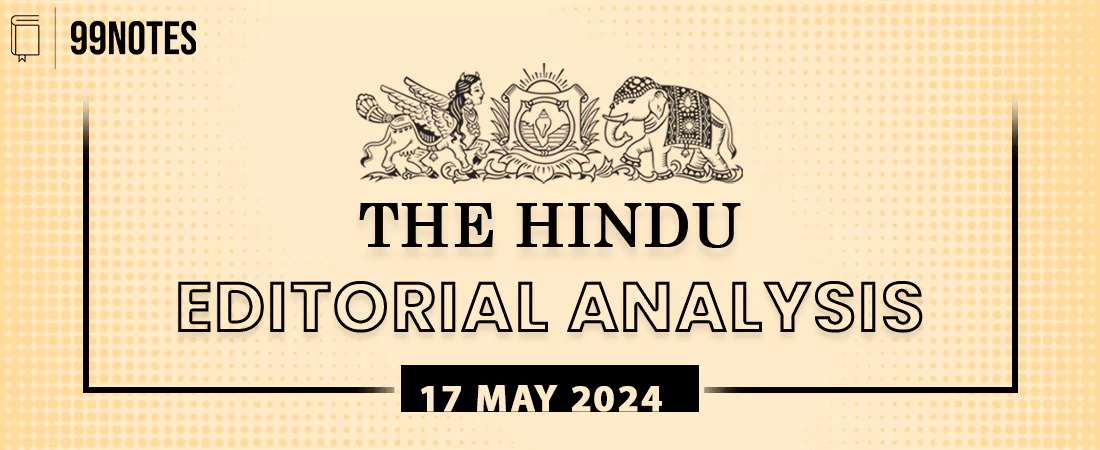17 May 2024 : The Hindu Editorial Notes PDF
1. Health advice to take with no pinch of salt
| Topic: GS2 – Social Justice – Health |
| Context |
| ● The article discusses the overshadowed public health issue of hypertension amidst concerns over COVID-19 vaccine risks.
● It highlights global and Indian perspectives on hypertension, public health initiatives like the India Hypertension Control Initiative, and strategies for prevention and control, including salt reduction and public awareness campaigns. |
Introduction
- The COVID-19 vaccine’s potential link to blood clot formation has drawn public attention away from the prevalent and preventable risk factor of hypertension, posing significant public health concerns.
| What Is Hypertension? |
| ● Definition: Hypertension, or high blood pressure, is a chronic medical condition characterised by elevated blood pressure in the arteries.
● Normal Blood Pressure: Typically defined as systolic blood pressure (pressure during heartbeats) below 120 mmHg and diastolic blood pressure (pressure between heartbeats) below 80 mmHg. ● Hypertension Classification: Hypertension is classified into stages based on blood pressure readings, ranging from elevated blood pressure to hypertensive crisis. ● Risk Factors: Risk factors include age, family history, obesity, excessive salt intake, lack of physical activity, and certain medical conditions. ● Complications: Hypertension can lead to serious complications such as heart disease, stroke, kidney disease, and vision loss if left untreated. ● Management: Management involves lifestyle modifications (diet, exercise, salt reduction) and, if necessary, medication to lower blood pressure and reduce the risk of complications. |
Global Perspective on Hypertension
- The World Health Organization (WHO) released its first report on hypertension, highlighting it as a silent killer due to often asymptomatic nature.
- Hypertension contributes to an estimated 10.8 million preventable deaths annually globally, surpassing other leading risk factors like tobacco use and high blood sugar.
- Despite its severity, nearly half of adults with hypertension are unaware of their condition, with only a fraction receiving diagnosis and treatment.
Hypertension in India
- The Indian Council of Medical Research-INdia DIABetes (ICMR-INDIAB) study estimates 311 million cases of hypertension in India, affecting one in three adults.
- The prevalence of hypertension exceeds that of diabetes by threefold.
Addressing Hypertension: Strategies and Initiatives
Salt Reduction
- Excess salt intake, a key risk factor for hypertension, contributes to cardiovascular disease deaths.
- Reduction in salt intake can substantially decrease cardiovascular disease risks and mortality rates.
Public Health Initiatives
- The India Hypertension Control Initiative (IHCI) focuses on primary healthcare and simplified treatment protocols.
- IHCI’s strategies include drug supply chain strengthening, decentralised care, and patient-centric measures like dispensing 30-day medicine supplies.
- Simplified treatment protocols and decentralised care improve access to healthcare services.
- Streamlined programme monitoring enhances performance assessment and scalability.
Future Course of Action
- Scaling up evidence-based interventions like IHCI is crucial.
- Efforts must target non-modifiable risk factors such as family history and age, alongside modifiable factors like salt consumption.
Multi-Sectoral Approach
- Multi-sectoral collaboration is essential for effective hypertension control.
- Strategies such as reducing dietary salt consumption and raising public awareness should be integrated into national health policies.
Public Awareness and Education
- Educating the public about the risks of hypertension and the importance of salt reduction is crucial.
- Enhanced food regulation enforcement and taxation on high-salt products can mitigate disease burden.
Regular Blood Pressure Monitoring
- Integrating regular blood pressure checks into daily life and workplace settings is vital.
- Access to blood pressure monitoring devices should be increased in public spaces and workplaces.
Conclusion
- Hypertension poses a significant public health challenge globally and in India, contributing to preventable deaths and morbidity.
- Comprehensive strategies focusing on salt reduction, public awareness, and multi-sectoral collaboration are essential for effective hypertension control.
- Regular blood pressure monitoring and lifestyle modifications are critical for preventing and managing hypertension at the population level.
| Practice Question: What are the challenges and initiatives in addressing the silent but significant public health issue of hypertension in India? Discuss the role of government programs, public awareness campaigns, and multi-sectoral collaborations in combating this prevalent condition. (150 Words /10 marks) |
2. Politics served with concise social media content
| Topic: GS1 – Indian Society – Effects of globalisation on Indian society
GS2 – Indian Polity |
| Context |
| ● The article explores the transformative impact of social media on political narratives and election outcomes in India.
● It delves into the rise of viral content designed for instant gratification, the inversion of traditional roles in setting political agendas, and the challenges it poses for analysis in a rapidly evolving media landscape. |
Introduction
- The rise of social media has revolutionised information dissemination, impacting political narratives and potentially altering election outcomes in India.
- Rapid decline in human attention spans, fueled by the popularity of concise social media content, has led to a shift towards content designed for instant virality rather than depth.
- Political parties are adapting to this new reality, leveraging social media to set and propagate political narratives.
Viral Content and Political Power
- Short, snappy content optimised for virality has empowered previously obscure figures to become influential by catering to short attention spans.
- Social media algorithms promote viral content, often overshadowing more substantial, factual narratives.
- Political parties, particularly the Bharatiya Janata Party (BJP), have capitalised on social media’s power to dominate political discourse.
The Power of Social Media:
- Viral political content, such as Dhruv Rathee’s video “Is India Becoming a Dictatorship,” can quickly set political narratives and garner widespread attention.
- The content, designed for virality, can be easily edited into short sections to appeal to shrinking attention spans.
- The viral spread of such content marks an inversion of traditional roles, with independent creators setting narratives amplified by political parties.
Impact and Analysis
- The democratisation of content creation and algorithms catering to shrinking attention spans have levelled the playing field in political discourse.
- Traditional media checks and balances are eroding, making analysis of political headwinds more challenging.
- Social media-generated narratives influence millions, necessitating a shift in focus from conventional messaging to social media-driven discourse analysis.
Conclusion
- Social media’s influence on political narratives and election outcomes in India is undeniable, with viral content setting the agenda and shaping public opinion.
- Political parties must adapt to this new reality, leveraging social media to their advantage while navigating the challenges of instant gratification and narrative control.
- The winner in this battle for attention will be the party that can effectively harness the power of social media to shape and control political discourse.
| Potential Impact of Social Media On Election Process: |
Pros of Social Media on Election Process:
Cons of Social Media on Election Process:
|
| PYQ: Use of Internet and social media by non-state actors for subversive activities is a major concern. How have these have misused in the recent past? Suggest effective guidelines to curb the above threat. (200 words/12.5m) (UPSC CSE (M) GS-3 2016) |
| Practice Question: How has the rise of social media and the prevalence of viral content reshaped political narratives and election dynamics in India? Discuss the implications of this shift for political discourse and the challenges it poses for analysis and governance. (250 Words /15 marks) |




